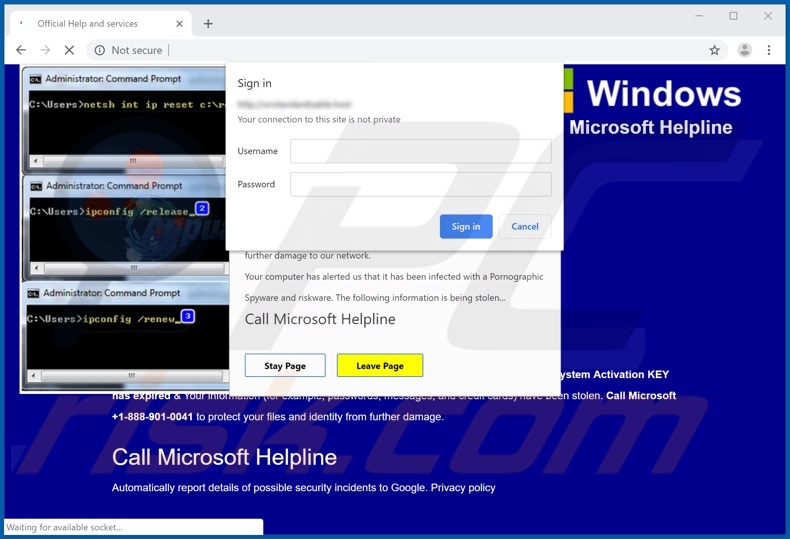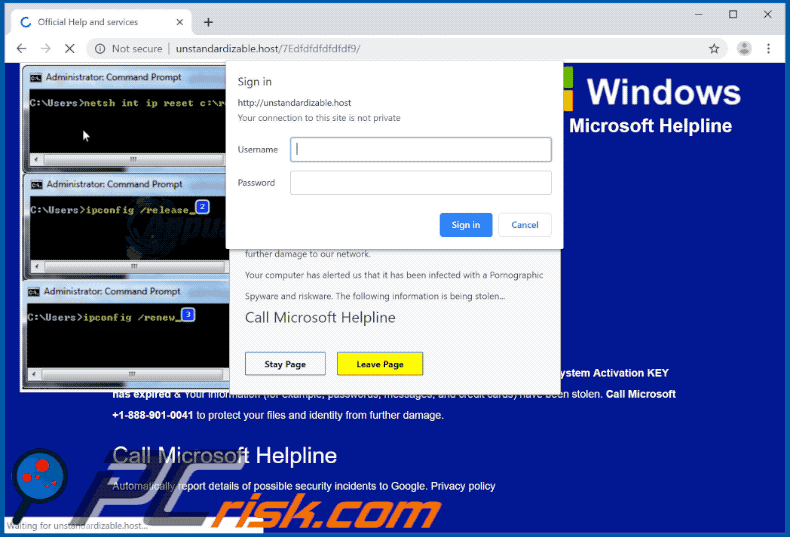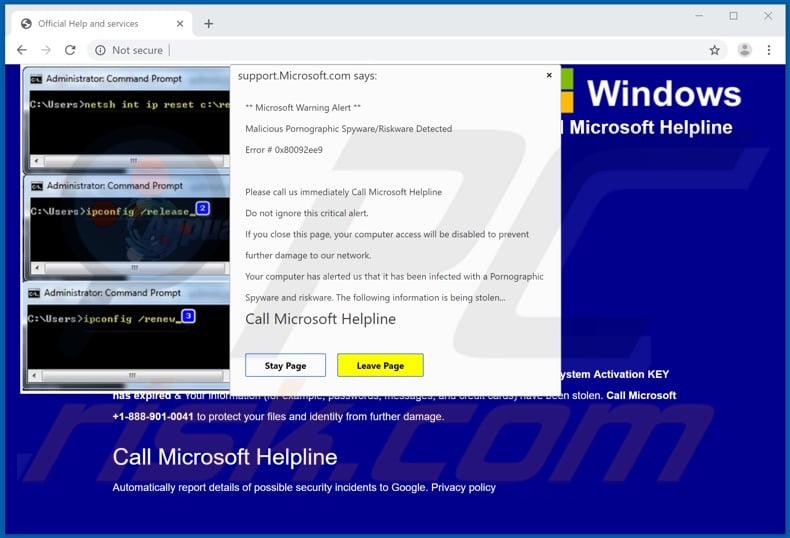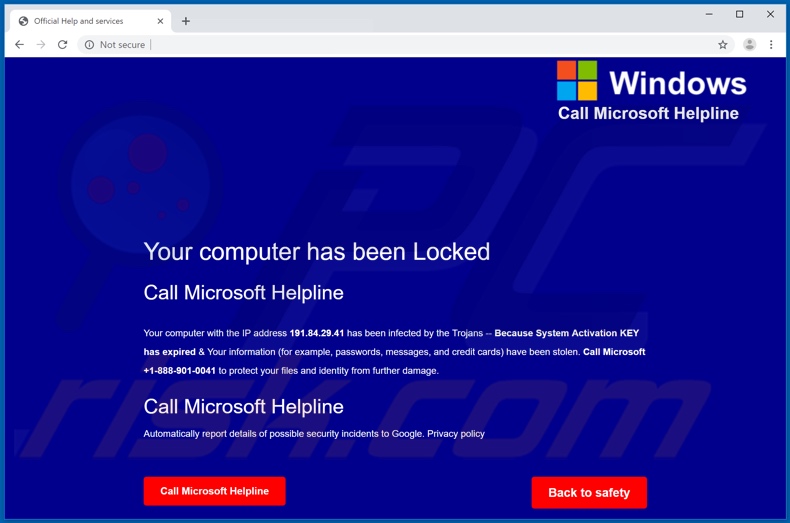Avoid the "Call Microsoft Helpline" scam
Phishing/ScamAlso Known As: Call Microsoft Helpline phishing scam
Get free scan and check if your device is infected.
Remove it nowTo use full-featured product, you have to purchase a license for Combo Cleaner. Seven days free trial available. Combo Cleaner is owned and operated by RCS LT, the parent company of PCRisk.com.
What is "Call Microsoft Helpline"?
"Call Microsoft Helpline" is a scam run by deceptive websites. It operates by tricking users into believing that their device is infected and that they need to contact the (fake) technical support provided to resolve the issues. Note that no website can detect threats present on users' systems and any claims to this effect cannot be trusted.
This specific scam claims to originate from Microsoft, however, this is also false. Microsoft has no association with "Call Microsoft Helpline". Few people visit these deceptive, rogue sites intentionally - most are redirected by intrusive advertisements or Potentially Unwanted Applications (PUAs) already present on the device.

Visitors first see a pop-up window with a message claiming that their connection to this web page is not secure and, therefore, they must sign-in. The background pop-up pertains to be a warning alert from Microsoft. This alarm states that "Malicious Pornography Spyware/Riskware" has been detected on the system.
Users are urged not to ignore this message and to contact the (fake) helpline without delay. It is stated that closing this web page will disable users' access to the device in order to prevent further damage to the network. To further alarm users, the pop-up implies that some sort of unmentioned information is currently being stolen from them.
The background states that the computer has been locked, due to it being infected with Trojan-type malware. This has allegedly happened due to the Windows activation key having expired. Supposedly, users' information (usernames and passwords, banking details, messaging history/contacts) has already been stolen.
To prevent further damage to their data and identities, the scam instructs users to call the number listed. The sole purpose of these scams is to generate revenue for their designers. There are many ways in which calling the fake technical support numbers can harm users and their devices.
These numbers can have high fees, even though it is often claimed that they are toll-free. It is also possible that users will be led through confusing instructions, which will require them to pay for bogus services. They might be instructed to purchase rogue, nonoperational software and/or tricked into downloading/installing malicious programs.
In some cases, deceptive web pages cannot be closed by simply closing the browser tab/window. Therefore, Task Manager should be used to terminate the browser process. Prior to reopening the browser, however, do not restore the previous session, otherwise the rogue site will also be reopened (or the web page that originally redirected to the scam will redirect to it again).
As mentioned, deceptive/scam websites are typically opened by PUAs. These apps often seem legitimate and offer a wide variety of "useful" features. In fact, they are rarely operational. Rather than delivering any real value, unwanted applications employ stealth means to generate revenue for their developers.
They can cause redirects to untrustworthy and malicious websites. Some can run intrusive ad campaigns. I.e., deliver unwanted and harmful ads. Others can hijack browsers and promote fake search engines. PUAs commonly have data tracking abilities.
They monitor users' browsing activity (URLs visited, pages viewed, search queries typed, etc.) and collect personal information (IP addresses, geolocations and other details). This sensitive data is then shared with third parties who use it for criminals purposes.
PUAs can not only cause browser and system infiltration and infections, but also lead to financial loss, severe privacy issues, and even identity theft. To protect device and user safety, remove all suspicious applications and browser extensions/plug-ins immediately upon detection.
| Name | Call Microsoft Helpline phishing scam |
| Threat Type | Phishing, Scam, Social Engineering, Fraud. |
| Fake Claim | Scam claims that user's device is infected and they need to contact technical support to prevent further damage. |
| Tech Support Scammer Phone Number | +1-888-901-0041 |
| Symptoms | Fake error messages, fake system warnings, pop-up errors, hoax computer scan. |
| Distribution methods | Compromised websites, rogue online pop-up ads, potentially unwanted applications. |
| Damage | Loss of sensitive private information, monetary loss, identity theft, possible malware infections. |
| Malware Removal (Windows) |
To eliminate possible malware infections, scan your computer with legitimate antivirus software. Our security researchers recommend using Combo Cleaner. Download Combo CleanerTo use full-featured product, you have to purchase a license for Combo Cleaner. 7 days free trial available. Combo Cleaner is owned and operated by RCS LT, the parent company of PCRisk.com. |
The internet is full of scam/rogue sites. They tend to use social engineering and scare tactics to encourage visitors into performing certain actions.
For example, calling fraudulent support numbers, and downloading, installing, or purchasing untrustworthy/malicious software, paying for fake services rendered, etc. "E.tre456_worm_Windows", "Norton Subscription Has Expired Today", and "What is Microsoft Alert Your Data Is At Risk" are some examples of other scams similar to "Call Microsoft Helpline".
How did potentially unwanted applications install on my computer?
PUAs often proliferate via the download/install set-ups of other programs. This deceptive marketing method of pre-packing regular software with unwanted or malicious content is called "bundling". Rushing download/installation processes (e.g. ignoring terms, skipping steps, etc.) increases the risk of unintentionally allowing bundled programs onto systems.
Some of these apps also have "official" download web pages. Intrusive advertisements can also spread this content. When clicked, they can execute scripts designed to download/install PUAs without users' consent.
How to avoid installation of potentially unwanted applications
Content should be researched carefully, prior to download/installation. Use only official and verified download channels. P2P sharing networks (BitTorrent, eMule, Gnutella, etc.), free file-hosting websites, third party downloaders and similar sources are untrustworthy, and using them is not advised.
When downloading/installing, read the terms, explore all available options, use the "Custom/Advanced" settings, and opt-out of additional apps, tools, features and so on. Intrusive ads usually seem legitimate and harmless, however, when clicked, they often redirect to dubious sites (e.g. pornography, adult-dating, gambling, etc.).
If you encounter ads/redirects of this type, inspect the device and immediately remove all dubious applications and/or browser extensions/plug-ins. If your computer is already infected with PUAs, we recommend running a scan with Combo Cleaner Antivirus for Windows to automatically eliminate them.
Text presented in "Call Microsoft Helpline" initial pop-up window:
Sign in
Your connection to this site is not private
Username
Password
The appearance of "Call Microsoft Helpline" pop-up (GIF):

Screenshot of the background pop-up:

Text presented in this pop-up window:
support.Microsoft.com says:
** Microsoft Warning Alert **
Malicious Pornography Spyware/Riskware Detected
Error # 0x80092ee9
Please call us immediately Call Microsoft Helpline
Do not ignore this critical alert.
If you close this page, your computer access will be disabled to prevent
further damage to our network.
Your computer has alerted us that it has been infected with a Pornographic
Spyware and riskware. The following information is being stolen...
Call Microsoft Helpline
Screenshot of the background page:

Text presented in this page:
Call Microsoft Helpline
Your computer has been Locked
Call Microsoft HelplineYour computer with the IP address 191.84.29.41 has been infected by the Trojans -- Because System Activation KEY has expired & Your information (for example, passwords, messages, and credit cards) have been stolen. Call Microsoft +1-888-901-0041 to protect your files and identity from further damage.
Call Microsoft Helpline
Automatically report details of possible security incidents to Google. Privacy policy
Instant automatic malware removal:
Manual threat removal might be a lengthy and complicated process that requires advanced IT skills. Combo Cleaner is a professional automatic malware removal tool that is recommended to get rid of malware. Download it by clicking the button below:
DOWNLOAD Combo CleanerBy downloading any software listed on this website you agree to our Privacy Policy and Terms of Use. To use full-featured product, you have to purchase a license for Combo Cleaner. 7 days free trial available. Combo Cleaner is owned and operated by RCS LT, the parent company of PCRisk.com.
Quick menu:
- What is Call Microsoft Helpline phishing scam?
- How to identify a pop-up scam?
- How do pop-up scams work?
- How to remove fake pop-ups?
- How to prevent fake pop-ups?
- What to do if you fell for a pop-up scam?
How to identify a pop-up scam?
Pop-up windows with various fake messages are a common type of lures cybercriminals use. They collect sensitive personal data, trick Internet users into calling fake tech support numbers, subscribe to useless online services, invest in shady cryptocurrency schemes, etc.
While in the majority of cases these pop-ups don't infect users' devices with malware, they can cause direct monetary loss or could result in identity theft.
Cybercriminals strive to create their rogue pop-up windows to look trustworthy, however, scams typically have the following characteristics:
- Spelling mistakes and non-professional images - Closely inspect the information displayed in a pop-up. Spelling mistakes and unprofessional images could be a sign of a scam.
- Sense of urgency - Countdown timer with a couple of minutes on it, asking you to enter your personal information or subscribe to some online service.
- Statements that you won something - If you haven't participated in a lottery, online competition, etc., and you see a pop-up window stating that you won.
- Computer or mobile device scan - A pop-up window that scans your device and informs of detected issues - is undoubtedly a scam; webpages cannot perform such actions.
- Exclusivity - Pop-up windows stating that only you are given secret access to a financial scheme that can quickly make you rich.
Example of a pop-up scam:

How do pop-up scams work?
Cybercriminals and deceptive marketers usually use various advertising networks, search engine poisoning techniques, and shady websites to generate traffic to their pop-ups. Users land on their online lures after clicking on fake download buttons, using a torrent website, or simply clicking on an Internet search engine result.
Based on users' location and device information, they are presented with a scam pop-up. Lures presented in such pop-ups range from get-rich-quick schemes to fake virus scans.
How to remove fake pop-ups?
In most cases, pop-up scams do not infect users' devices with malware. If you encountered a scam pop-up, simply closing it should be enough. In some cases scam, pop-ups may be hard to close; in such cases - close your Internet browser and restart it.
In extremely rare cases, you might need to reset your Internet browser. For this, use our instructions explaining how to reset Internet browser settings.
How to prevent fake pop-ups?
To prevent seeing pop-up scams, you should visit only reputable websites. Torrent, Crack, free online movie streaming, YouTube video download, and other websites of similar reputation commonly redirect Internet users to pop-up scams.
To minimize the risk of encountering pop-up scams, you should keep your Internet browsers up-to-date and use reputable anti-malware application. For this purpose, we recommend Combo Cleaner Antivirus for Windows.
What to do if you fell for a pop-up scam?
This depends on the type of scam that you fell for. Most commonly, pop-up scams try to trick users into sending money, giving away personal information, or giving access to one's device.
- If you sent money to scammers: You should contact your financial institution and explain that you were scammed. If informed promptly, there's a chance to get your money back.
- If you gave away your personal information: You should change your passwords and enable two-factor authentication in all online services that you use. Visit Federal Trade Commission to report identity theft and get personalized recovery steps.
- If you let scammers connect to your device: You should scan your computer with reputable anti-malware (we recommend Combo Cleaner Antivirus for Windows) - cyber criminals could have planted trojans, keyloggers, and other malware, don't use your computer until removing possible threats.
- Help other Internet users: report Internet scams to Federal Trade Commission.
Share:

Tomas Meskauskas
Expert security researcher, professional malware analyst
I am passionate about computer security and technology. I have an experience of over 10 years working in various companies related to computer technical issue solving and Internet security. I have been working as an author and editor for pcrisk.com since 2010. Follow me on Twitter and LinkedIn to stay informed about the latest online security threats.
PCrisk security portal is brought by a company RCS LT.
Joined forces of security researchers help educate computer users about the latest online security threats. More information about the company RCS LT.
Our malware removal guides are free. However, if you want to support us you can send us a donation.
DonatePCrisk security portal is brought by a company RCS LT.
Joined forces of security researchers help educate computer users about the latest online security threats. More information about the company RCS LT.
Our malware removal guides are free. However, if you want to support us you can send us a donation.
Donate
▼ Show Discussion